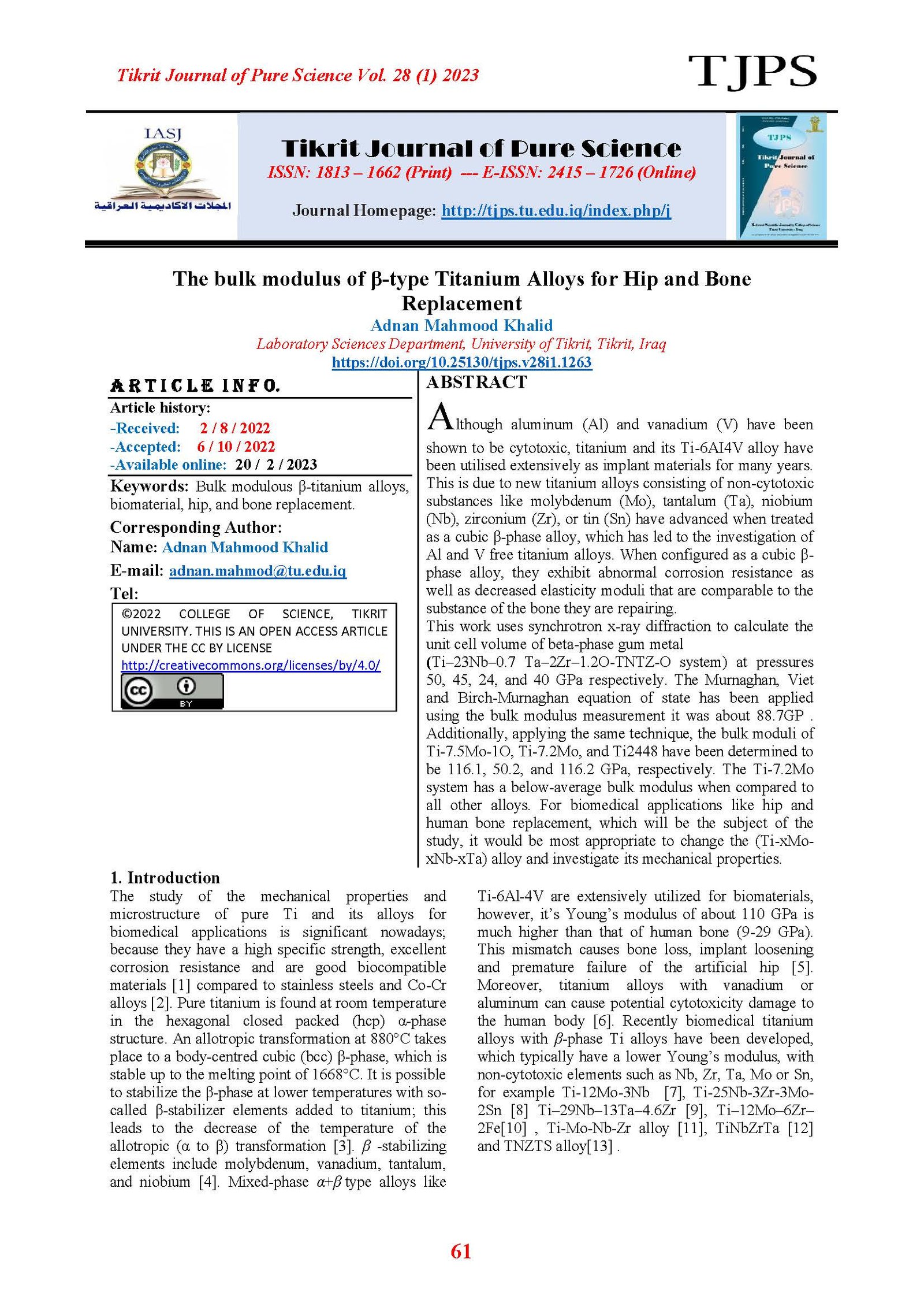The bulk modulus of β-type Titanium Alloys for Hip and Bone Replacement
Main Article Content
Abstract
Although aluminum (Al) and vanadium (V) have been shown to be cytotoxic, titanium and its Ti-6AI4V alloy have been utilised extensively as implant materials for many years. This is due to new titanium alloys consisting of non-cytotoxic substances like molybdenum (Mo), tantalum (Ta), niobium (Nb), zirconium (Zr), or tin (Sn) have advanced when treated as a cubic β-phase alloy, which has led to the investigation of Al and V free titanium alloys. When configured as a cubic β-phase alloy, they exhibit abnormal corrosion resistance as well as decreased elasticity moduli that are comparable to the substance of the bone they are repairing.
This work uses synchrotron x-ray diffraction to calculate the unit cell volume of beta-phase gum metal
(Ti–23Nb–0.7 Ta–2Zr–1.2O-TNTZ-O system) at pressures 50, 45, 24, and 40 GPa respectively. The Murnaghan, Viet and Birch-Murnaghan equation of state has been applied using the bulk modulus measurement it was about 88.7GP . Additionally, applying the same technique, the bulk moduli of Ti-7.5Mo-1O, Ti-7.2Mo, and Ti2448 have been determined to be 116.1, 50.2, and 116.2 GPa, respectively. The Ti-7.2Mo system has a below-average bulk modulus when compared to all other alloys. For biomedical applications like hip and human bone replacement, which will be the subject of the study, it would be most appropriate to change the (Ti-xMo-xNb-xTa) alloy and investigate its mechanical properties.
Article Details

This work is licensed under a Creative Commons Attribution 4.0 International License.
Tikrit Journal of Pure Science is licensed under the Creative Commons Attribution 4.0 International License, which allows users to copy, create extracts, abstracts, and new works from the article, alter and revise the article, and make commercial use of the article (including reuse and/or resale of the article by commercial entities), provided the user gives appropriate credit (with a link to the formal publication through the relevant DOI), provides a link to the license, indicates if changes were made, and the licensor is not represented as endorsing the use made of the work. The authors hold the copyright for their published work on the Tikrit J. Pure Sci. website, while Tikrit J. Pure Sci. is responsible for appreciate citation of their work, which is released under CC-BY-4.0, enabling the unrestricted use, distribution, and reproduction of an article in any medium, provided that the original work is properly cited.
References
[1] Wang, X., Li, Y., Xiong, J., Hodgson, P. D., and Wen, C. E. (2009). Porous TiNbZr alloy scaffolds for biomedical applications. Acta biomaterialia, 5(9): 3616-3624. [2] Niinomi, M. (2008). Mechanical biocompatibilities of titanium alloys for biomedical applications. Journal of the mechanical behavior of biomedical materials, 1(1): 30-42.
[3] Jackson, M. J., Handy, R. G., Whitfield, M. D., Burgess, J. W., Robinson, G. M., Novakov, T., Phoenix, D. A. (2014). 9.1 Metallurgical Aspects. Anti-Abrasive Nanocoatings: Current and Future Applications, 225.
[4] Welsch, G., Boyer, R., & Collings, E. (1993). Materials properties handbook: titanium alloys: ASM international.
[5] Wang, X., Chen, Y., Xu, L., Xiao, S., Kong, F., & Woo, K. D. (2011). Ti–Nb–Sn–hydroxyapatite composites synthesized by mechanical alloying and high frequency induction heated sintering. J Mech Behav Biomed Mater, 4(8): 2074-2080.
[6] Wang, X., Chen, Y., Xu, L., Liu, Z., & Woo, K.-D. (2013). Effects of Sn content on the microstructure, mechanical properties and biocompatibility of Ti–Nb–Sn/hydroxyapatite biocomposites synthesized by powder metallurgy. Materials & Design, 49(0): 511-519.
[7] Niinomi, M., Nakai, M., & Hieda, J. (2012). Development of new metallic alloys for biomedical applications. Acta Biomater, 8(11), 3888-3903. http://dx.doi.org/10.1016/j.actbio.2012.06.037.
[8] Tian, Y., Yu, Z., Ong, C. Y. A., Kent, D., & Wang, G. (2015). Microstructure, elasticdeformation behavior and mechanical properties of biomedical β-type titanium alloy thin-tube used for stents. J Mech Behav Biomed Mater, 45(0): 132-141. http://dx.doi.org/10.1016/j.jmbbm.2015.02.001.
[9] Y.L. Hao, M. Niinomi, D. Kuroda, K. Fukunaga, Y.L. Zhou, R. Yang, A. Suzuki . Metall. Mater. Trans., A, 33A (2002), p. 3137 [10] Rack, H.J. and Qazi, J.I., 2006. Titanium alloys for biomedical applications. Materials Science and Engineering: C, 26(8), p: 1269-1277.
[11] Nnamchi, P. S., Obayi, C. S., Todd, I., & Rainforth, M. W. (2016). Mechanical and electrochemical characterisation of new Ti–Mo–Nb–Zr alloys for biomedical applications. Journal of the Mechanical Behavior of Biomedical Materials, 60, 68-77.
[12] Luo, X., Yang, C., Li, R. Y., Wang, H., Lu, H. Z., Song, T., ... & Li, Y. Y. (2022). Effect of silicon content on the microstructure evolution, mechanical properties, and biocompatibility of β-type TiNbZrTa alloys fabricated by laser powder bed fusion. Biomaterials Advances, 133, 112625.
[13] Luo, X., Liu, L. H., Yang, C., Lu, H. Z., Ma, H. W., Wang, Z., ... & Li, Y. Y. (2021). Overcoming the strength–ductility trade-off by tailoring grain-
boundary metastable Si-containing phase in β-type titanium alloy. Journal of Materials Science & Technology, 68, 112-123. [14] Edmund Bühler GmbH. 2014. Compact Arc Melter MAM-1. [15] Connolly, J. R. (2007). Introduction to X-ray powder diffraction. Material in this document is. [16] F.D. Murnaghan, 'The Compressibility of Media under Extreme Pressures', in Proceedings of the National Academy of Sciences, vol. 30: p. 244-247, 1944. [17] Francis Birch, 'Finite Elastic Strain of Cubic Crystals', in Physical Review, vol. 71, pp. 809-824 (1947). [18] Pascal Vinet, John R. Smith, John Ferrante and James H. Rose (1987). "Temperature effects on the universal equation of state of solids". Physical Review B. 35 (4): 1945–1953. doi:10.1103/physrevb.35.1945. hdl: 2060/19860019304 .
[19] F.D. Stacey; B. J. Brennan; R. D. Irvine (1981). "Finite strain theories and comparisons with seismological data". Surveys in Geophysics. 4 (4): 189–232. doi:10.1007/BF01449185.
[20] Cardoso, G.C., de Almeida, G.S., Corrêa, D.O.G., Zambuzzi, W.F., Buzalaf, M.A.R., Correa, D.R.N. and Grandini, C.R., 2022. Preparation and characterization of novel as-cast Ti-Mo-Nb alloys for biomedical applications. Scientific Reports, 12(1), pp.1-9. [21] Raganya, L., Moshokoa, N., Obadele, B.A., Olubambi, P.A. and Machaka, R., 2021. Investigation of the tensile properties of heat treated Ti-Mo alloys. Materials Today: Proceedings, 38, pp.1044-1048.
